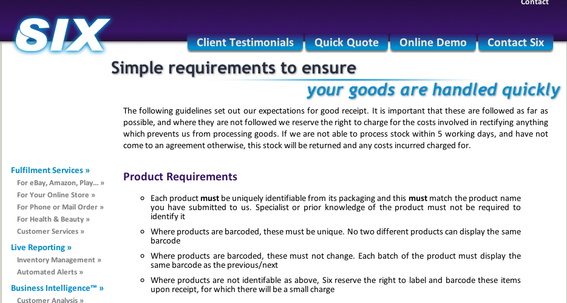In the beginning, you might be content that your inventory suppliers have simply delivered your goods on time. But as you grow and take on more lines, more staff, or outsource to a fulfillment company, you’ll quickly find that the arrival of poorly marked goods can waste time.
In this article I’ll look at the common issues with wholesale product suppliers, the problems they can cause and how you can go about streamlining your relationship with them.
The Problems Inventory Suppliers Can Cause
Supplier delivery problems affect much more of your business than you probably think. It’s not just about them not being able to supply a product. Everything from the time it takes to unpack the box, to the item being received by the customer, can be affected by how efficient your suppliers are. Here’s a list of the main areas where your inventory suppliers could be costing you money.
- Poorly packed boxes. Takes time to unpack the box when it arrives.
- Identifying supplier, contents. Takes time to work out who sent it, and what should have been in the order.
- Unpacking problems. Must separate and identify each different item in the order.
- Shortfalls. Must follow-up on shortfalls, wrong items and arranging returns with the supplier.
- Delays. Staff has to follow-up on delayed orders with customers due to the above.
- Customer service problems. Have to process and pay for customer returns due to poor quality, incomplete or poorly presented goods.
- Customer returns. Must process and pay for customer returns when the wrong item is sent, due to poorly labeled or bar-coded goods from the supplier.
The costs can be quite far reaching. Many, especially those involving the customer, will be problems that can be solved or reduced by keeping more stock and diligently checking every item you receive. This doesn’t solve the problem, however. It just wastes time elsewhere in your business and results in you having money unnecessarily tied up in stock. In nearly every instance where companies have successfully run a “just in time” stock system, it has involved a strong working relationship with those suppliers. That means getting them to understand your problems and working together to make business better.
Keep Track of the Problems
Every time you have a problem with unpacking an order, write it down in a list along with the supplier’s name. After a few weeks you should have a comprehensive list of what wastes your time, and your staff’s time. Some common issues are the following.
- Poor packing. Many different, but similar items — jumbled loose in one big box — that are difficult to sort.
- Poor communication. No delivery note, so no way of knowing what’s missing or what they were unable to ship.
- Bad packing materials. Packing peanuts/shredded paper that goes all over the floor and you have to sweep up.
- Damaged goods. Poorly packed goods damaged in transit.
- Inferior quality. Poor quality items resulting in a lot of customer dissatisfaction and returns.
- Unidentified items. Products with no markings at all; new staff will be unable to recognize.
- Inconsistent packing. A product that can come in different packaging every week, confusing staff and customers.
- Bar code errors. Several different products with the same bar code, allowing mistakes when you come to pack an order.
Make Reasonable Requests to Correct Problems
You must be realistic here. Obviously the supplier isn’t going to ship everything in gold tissue paper just because you asked. But any serious supplier should meet your reasonable requests. One way to tell if your request is realistic and likely to be adhered to is to think about whether it would apply to other business that they supply and if there would be benefits for the supplier. For instance, asking your suppliers to change to brown paper sheets from loose fill is likely to be something all their customers would appreciate, and it may save them time and money too.
Adopt a Specification Sheet
At my fulfillment company, we publish a list of requirements or supplier guidelines for our clients’ use. Most companies do this to ensure consistency when goods are delivered. Some large companies — Walmart, Amazon — will publish a small book on requirements, although for the most part they are little more than common sense.

Developing a guidelines and requirements for your suppliers will help them. This graphic shows the packing and receiving guidelines for the author’s fulfillment company.
If a supplier fails to meet the specifications, there is a table of fines that are applied. But practically, these are only implemented where deficiencies have caused delays and inconvenience. As a small business, it’s likely your suppliers will no agree to a system of financial fines, but that doesn’t stop you from making it known you are dissatisfied with them each time it happens. You should point out that if it’s causing you problems, it’s most likely an issue for their other customers and so improving their business processes would be of benefit to everyone.




